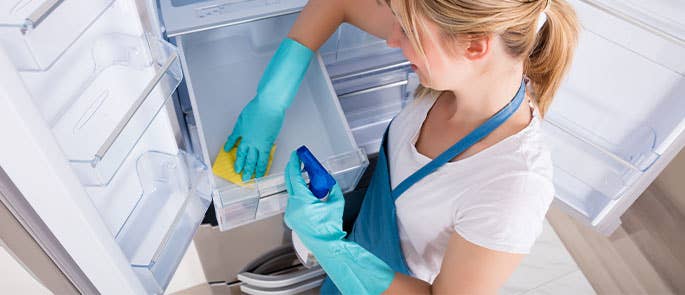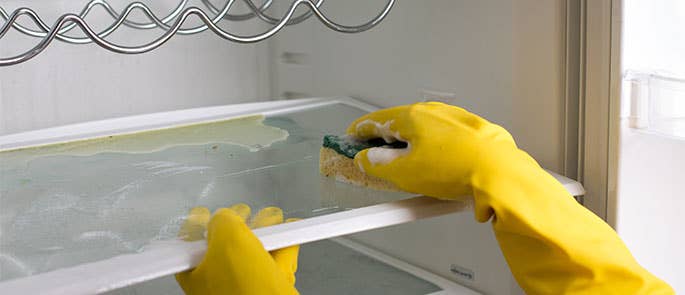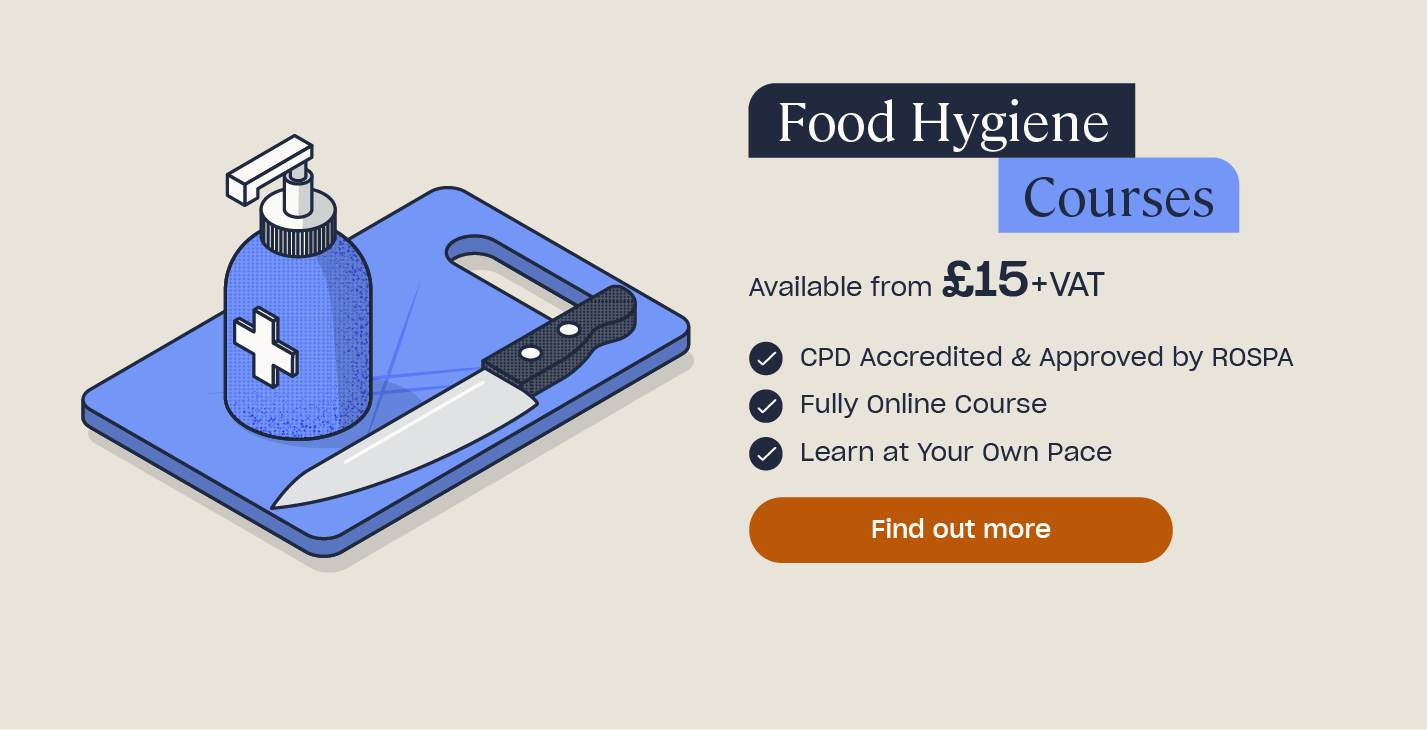How to Clean a Fridge
Keeping your fridge clean is an essential part of maintaining a safe and hygienic kitchen. Whether at home or in a commercial setting, a clean fridge not only increases food safety, but also reduces waste and keeps your appliance running efficiently. In this article, we’ll explain why cleaning your fridge matters, how often to clean your fridge and the best way to carry out a thorough clean.

Why is Cleaning your Fridge Important?
Cleaning your fridge is not just about appearances – it’s crucial for food safety and hygiene. Cleaning your fridge is important because it:
- Prevents harmful bacterial growth on food.
- Reduces the risk of foodborne illness and food poisoning.
- Prevents cross-contact between food items which could potentially cause an allergic reaction for someone.
- Prevents unpleasant odours.
- Improves efficiency and extends the life of your fridge.
- Reduces food waste and saves money by letting you see what you have, avoiding duplicate purchases and expired food.
- Improves your chances of achieving a high Food Hygiene Rating in commercial kitchens.
- Helps maintain good food hygiene standards in commercial kitchens and ensures legal compliance.
Looking to Learn More?
If you work in a setting with food, whether you prepare, serve or sell it, then having an understanding of food allergens and the risks of cross-contact is vital. Our Food Allergen Awareness Training teaches you everything you need to know about this important topic.
How Often Should you Clean your Fridge?
Your fridge at home should be cleaned as often as you deem necessary but, as a guide:
Perform a quick wipe down every week. Wipe the shelves, drawers and door handles to remove spills and crumbs and check for any expired food.
Do a deep clean at least once every three months. This involves removing everything from the fridge and thoroughly cleaning the inside before putting food back in it.
For commercial fridges, spot cleaning should be done daily, deep cleaning should be done far more frequently, often weekly, and thorough cleaning of all the fridge’s internal and external elements should be done monthly. It’s also recommended that commercial fridges are professionally serviced every year to ensure they remain efficient.
How to Clean a Fridge
You don’t need specialist equipment or chemicals to clean a fridge – most of the time it can be cleaned simply with soap and water, meaning anyone can do it at any time. The targeted steps below will help you learn more about how to to clean each part of your fridge, whether domestic or commercial:
How to Clean Fridge Drain Hole
Unblock the drain hole with a pipe cleaner or cotton bud to prevent leaks and water build-up. Flush with warm soapy water and dry.
How to Clean Fridge Coils
Switch off the fridge and pull the fridge away from the wall. Use a vacuum or soft brush to remove dust from the coils. This will help your fridge to run more efficiently.
How to Clean Fridge Drip Tray
Remove the drip tray if accessible, then empty it and wash with warm soapy water before drying and replacing.
How to Clean Fridge Drip Pan
If your fridge has a drip pan, slide it out carefully, clean with hot soapy water and dry fully to prevent mould growth.
How to Clean Fridge Seals
Wipe fridge seals with warm water and mild detergent, using a toothbrush to loosen any trapped dirt. Dry thoroughly to avoid mould.

How to Clean Fridge Outside
Wipe the exterior of the fridge with a damp cloth and mild cleaner. For stainless steel, use a specialist cleaner or a vinegar solution to reduce streaks.
How to Clean Fridge Shelves
Remove the shelves and drawers, wash them in warm soapy water, rinse clean and dry before replacing.
How to Clean Fridge Water Dispenser
Check the manufacturer’s instructions for your particular fridge but, in general, you can flush the dispenser with warm water to clean it out. Wipe the dispenser area regularly to prevent limescale and bacteria.
How to Clean Fridge Filter
Replace the water filter every 6 months or as recommended by the manufacturer. Rinse the filter housing before fitting the new filter.
How to Clean Fridge with Vinegar
You can use a mixture of vinegar and warm water to clean shelves and surfaces. Vinegar acts as a natural disinfectant and deodoriser.
Fridge Cleaning Tips
Use the following top 10 fridge cleaning tips to get the most out of your fridge, whether at home or in a commercial setting:
- Keep a small open container of bicarbonate of soda inside the fridge to absorb odours.
- Store food on the correct shelves (raw meat at the bottom, ready-to-eat foods higher up) to reduce contamination risks.
- Regularly check and rotate food by use-by dates to prevent waste.
- Avoid overfilling your fridge so air can circulate properly.
- Use caution with bleach, as while it is effective at disinfecting, it can pose a chemical hazard if not rinsed properly and may damage some surfaces.
- Wipe up spills immediately to prevent sticky residue and bacteria from spreading to other foods through cross-contamination.
- Clean fridge door seals regularly, as dirt and crumbs can stop them from sealing properly and make the fridge less efficient.
- Remove and wash shelves, drawers and racks with warm soapy water for a thorough clean.
- Keep a thermometer inside the fridge to ensure the fridge remains at a safe operating temperature (ideally 3 to 5 °C).
- Defrost the freezer compartment of your fridge periodically (if it’s not frost-free) to maintain efficiency and hygiene.
Keeping your fridge clean is essential for food safety, fridge efficiency and reducing food waste. Regular wiping, deep cleaning and proper organisation help to prevent bacteria, odours, cross-contact and cross-contamination. Whether at home or in a commercial kitchen, following good cleaning routines not only supports food hygiene but also saves you money and ensures compliance with food safety standards.
Further Resources:
- Food Hygiene Courses
- Do You Know Which Fridge Shelves You Should Store Your Food On?
- Guidance on Storing Leftovers and Partly Opened Foods
- How to Clean a Microwave
- How to Clean a Blender
- How to Clean an Oven
- How to Clean an Air Fryer
- How to Clean a Kitchen
- How to Clean a Dishwasher







